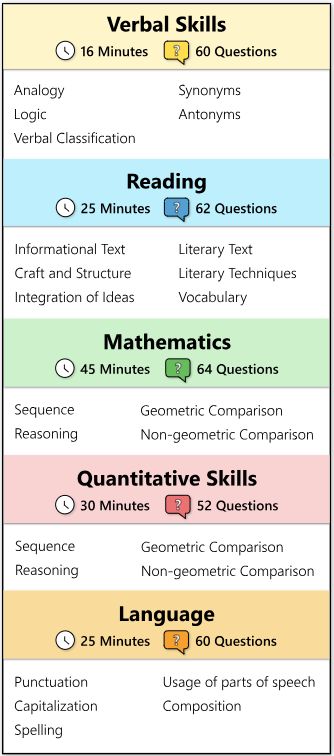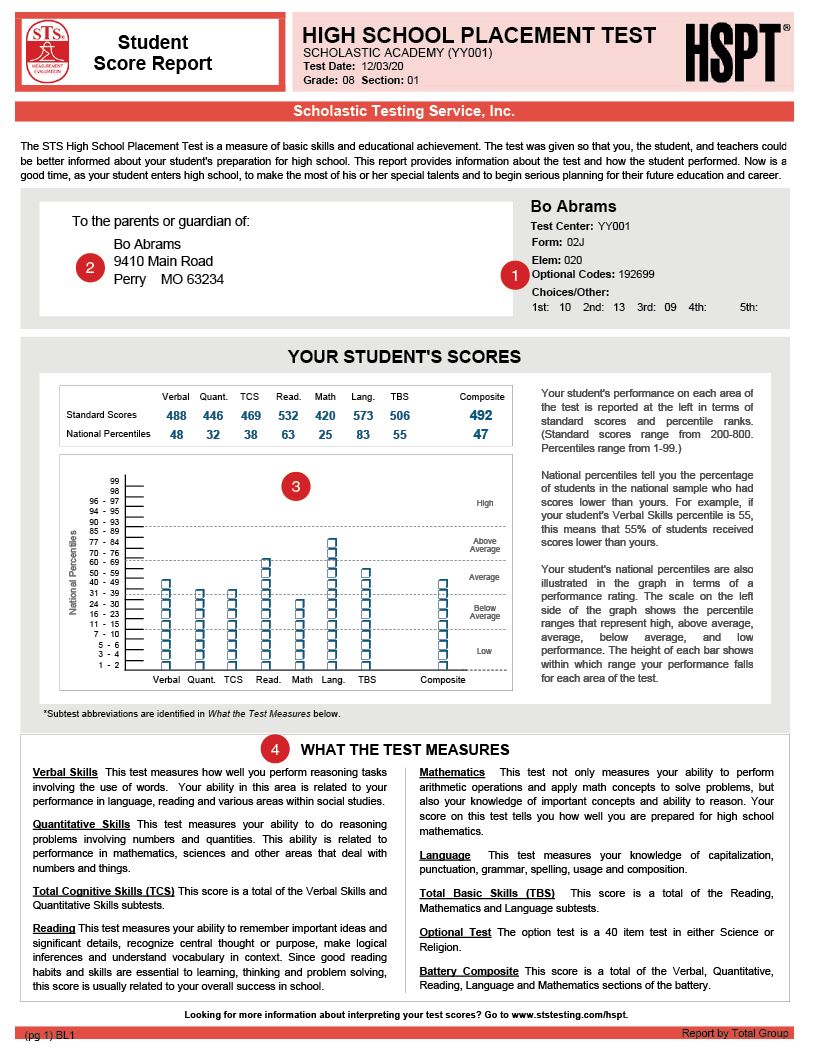
Everything You Should Know About the HSPT
The High School Placement Test (HSPT) is a standardized exam utilized by private parochial high schools as a component of the admission process for eighth-grade students.

Photo by Ketut Subiyanto
This blog was most recently updated in August 2025.
What is HSPT?
The High School Placement Test (HSPT) is a standardized exam utilized by private parochial high schools as a component of the admission process for eighth-grade students. Alongside factors such as GPA, transcripts, applications, essays, and interviews where applicable, the HSPT forms part of the application package. The results of the HSPT play a crucial role in schools' decisions regarding admissions, curriculum placement, and – what sets it apart from other high school entrance exams – scholarship awards!
The HSPT’s primary purpose is to assess students' current knowledge and skill sets, ensuring they are appropriately placed within the high school course curriculum. For a more comprehensive understanding of high school admissions, one can refer to additional resources such as this article: Everything You Need to Know About Private School Admissions.
It's worth noting that many of the Catholic High Schools in New York City use the TACHS exam, rather than the HSPT, though not all.
How is HSPT different from ISEE and SSAT?
The HSPT, ISEE, and SSAT are all standardized tests utilized for admission to various independent, parochial, and boarding schools. While many schools may accept either the ISEE or SSAT, it is crucial to examine the specific requirements of each institution before determining which exam to take. Notably, private schools typically rely on the ISEE and SSAT for admitting freshmen and class placement, whereas Catholic high schools generally do not utilize these tests, although some may require them.
The HSPT is specifically designed for ninth-grade entry, differing from the ISEE, which accommodates students from second to twelfth grade, and the SSAT, which caters to students from fifth to twelfth grade.
What is the difference between HSPT, TACHS and COOP?
The HSPT, TACHS, and COOP are all standardized tests utilized for admission to various Catholic high schools. While the TACHS and HSPT cover similar material, the TACHS is generally perceived as more straightforward and offers more time per question compared to the HSPT.
Specifically known as the Test for Admission into Catholic High Schools, the TACHS is exclusively required for eighth-graders seeking admission to Catholic high schools within the Diocese of Brooklyn/Queens and the Archdiocese of New York.
Meanwhile, the COOP, formally known as the Cooperative Admissions Examination Program, is administered to eighth-graders aspiring to attend Catholic high schools within New Jersey's Archdiocese of Newark or Diocese of Paterson.
| Test | Purpose | Target Grade | Subjects Covered | Format | Scoring | Pricing |
| HSPT | Admission to selected Catholic high schools in NYC | Eighth-graders | Verbal Skills, Quantitative Skills, Reading, Mathematics, Language + Science, Mechanical Aptitude, and Catholic Religion (optional) | Multiple-choice | Scaled score (200-800) and a percentile score (1-99) | $25 |
| TACHS | Admission to Catholic high schools in Diocese of Brooklyn/Queens and Archdiocese of New York | Eighth-graders | Reading, Written Expression, Mathematics, and Ability | Multiple-choice | Scaled score (200-800) and a percentile score (1-99) | $71 |
| COOP | Admission to Catholic high schools in Archdiocese of Newark and Diocese of Paterson in New Jersey | Eighth-graders | Sequences, Analogies, Quantitative Reasoning, Verbal Reasoning, Reading and Language Arts, Mathematics | Multiple-choice | Scaled score (200-800) and a percentile score (1-99) | $60 |
Which Schools Accept HSPT?
The HSPT is accepted by several of New York City's most competitive Catholic high schools, encompassing institutions such as Regis, Xavier, Loyola, and Fordham. Numerous private schools across New York City utilize the HSPT as a scholarship test such as Xavier High School, Xaverian High School, St. Peter’s Prep, Loyola, Fordham Prep, Marymont, Fontbonne Hall Academy, and St. Joseph Hill.
It's important to note that while many schools accept the HSPT, it's always advisable to check with the administration of the schools your child is interested in to ascertain which test they prefer or accept for admission.
When is HSPT in 2025?
The HSPT test is typically held in late November or early December. The test can only be taken once.
The HSPT test for New York is being held at Regis High School on Saturday, November 15, 2024. Bronx, Manhattan, and Queens residents will take the exam at 8:30 a.m. Students from other geographic regions will take the exam at 12:30 p.m.
For accurate and up-to-date information on the specific 2025 test date for admittance in the 2026-2027 school year, it's recommended to refer to the websites of the schools to which you're applying, or contact the administration of the relevant schools.
How to register for the HSPT?
To register for the HSPT, it's essential to understand that the school where you plan to take the exam may have specific criteria and procedures for registration. Therefore, the first step is to contact the high school where you intend to take the test and inquire about their registration process.
Typically, the cost of the HSPT registration ranges from $20 to $25, depending on the school administering the test.
For detailed information about registration and any other requirements, it's recommended to contact each school individually. This ensures you have the most up-to-date and relevant information tailored to the specific school's policies and procedures.
Is the HSPT digital?
While some schools do choose to offer a digital version, the HSPT largely remains a pencil and paper exam.
HSPT Sections
The HSPT comprises five required sections, which are Verbal Skills, Reading, Mathematics, Quantitative Skills, and Language. Additionally, there are three optional sections—Science, Mechanical Aptitude, and Catholic Religion— which may be required depending on the policies of the school you are applying to. It's important to note that while scores on the optional sections are not factored into the composite score, they may influence curriculum placement.

HSPT Verbal Skills
The Verbal Skills section of the HSPT is timed for 16 minutes and contains 60 questions, allowing approximately 16 seconds per question. Within this section, you can expect questions covering various specific topics. Analogy questions, for instance, require you to identify pairs of words with similar relationships, such as "kitten is to cat as puppy is to dog."
Logic questions are also included, featuring basic reasoning scenarios where you need to deduce the validity of statements based on given premises, such as comparing heights among individuals. Additionally, verbal classification questions ask you to categorize words, typically nouns, such as determining that a car is a vehicle.
Furthermore, you'll encounter synonyms, where you must select the word closest in meaning to the provided one, as well as antonyms, where you need to identify the word most opposite in meaning.
HSPT Reading
The Reading section of the HSPT is allotted 25 minutes and comprises 62 questions, providing approximately 24 seconds per question. This segment is divided into two parts: comprehension and vocabulary. The vocabulary component typically includes words derived from 8th-grade reading materials. Meanwhile, the comprehension part consists of passages followed by questions that assess your ability to understand various aspects of the text.
Within the comprehension part, you can expect questions covering specific topics such as informational text, craft and structure, integration of ideas, literary text, literary techniques, and vocabulary. These questions are designed to evaluate your comprehension skills, including your ability to analyze and interpret different types of texts effectively.
HSPT Mathematics
The Mathematics section of the HSPT is scheduled for 45 minutes and consists of 64 questions, allowing approximately 42 seconds per question.
The questions within this section cover various specific topics, which are also mirrored in the Quantitative Skills section. These topics include sequence, reasoning, geometric comparison, and non-geometric comparison. You'll encounter questions that require you to apply mathematical principles to analyze sequences, make logical deductions, compare geometric shapes, and make comparisons between non-geometric quantities.
HSPT Quantitative Skills
The Quantitative Skills section of the HSPT is allotted 30 minutes and consists of 52 questions, providing approximately 34 seconds per question.
While there is considerable overlap in concepts between the Quantitative Skills and Mathematics sections of the HSPT, the Quantitative Skills section tends to present these concepts more as word problems rather than equations. This means you'll be required to apply mathematical reasoning to interpret and solve problems presented in a contextual format.
HSPT Language
The Language section of the HSPT lasts for 25 minutes and comprises 60 questions, allowing approximately 25 seconds per question.
The questions within this section cover topics such as punctuation, capitalization, spelling, usage of parts of speech, and composition. You'll encounter questions that require you to demonstrate your understanding and application of proper punctuation and capitalization rules, as well as your ability to spell correctly. Additionally, you'll be tested on your knowledge of the usage of different parts of speech, such as nouns, verbs, adjectives, and adverbs.
Furthermore, the composition aspect of this section may involve questions related to sentence structure, grammar, and overall coherence and clarity of written expression.
How Long is the HSPT?
The HSPT has a total duration of 2 hours and 21 minutes for completing all the required sections. However, it's important to plan for a total test time of about 3 hours, including breaks.
How Many Questions are on the HSPT?
The HSPT consists of a total of 298 questions across all its sections.
HSPT Scores
The scale the test is scored on provides a possibility of 200 to 800 points for the test. Each school sets the score they require a student to receive.
How is HSPT scored?
The test derives a raw score by adding up the number of correct answers in each section.
This raw score is then converted into a composite standard score (200-800). Each student’s standard score is compared to test results from a national sample of students or a local sample of students to produce a national percentile (NP) or local percentile (LP) ranking respectively.
The percentile ranking indicates what percentage of students in the sample scored less than you.
Standard score and either the NP and LP rank are 3 of the normative scores that a school may decide to use, the other two are Grade Equivalent (GE) and Cognitive Skills Quotient (CSQ).
This GE score compares your performance with the average performance of students at other grade levels. The CSQ score serves to predict your future academic performance, replacing the traditional IQ score. It can be interpreted using the same IQ score guide.
How hard is HSPT?
The HSPT is widely recognized as a very challenging exam, requiring dedicated study and preparation for success. Unlike other standardized tests where students may rely on being strong in one subject area, such as math or language, the HSPT demands a well-rounded understanding across all sections. It's essential for students to commit to comprehensive study to excel on the exam.
Compared to other high school admission tests like the TACHS, ISEE, and SSAT, the HSPT typically provides less time per question. This means that students must not only master the content but also develop strong time-management skills to ensure they can complete each section within the allotted time frame.
Additionally, it's important to recognize that the material covered on the HSPT is at a level comparable to medium-level material on the SAT. This underscores the importance of mastering the material on the HSPT, as it will serve as a foundation for future academic success. Students should approach the HSPT with diligence and dedication, understanding that their performance on this exam can significantly impact their high school admissions process and future academic endeavors.
What is a good HSPT score?
Determining what constitutes a good HSPT score depends on various factors such as your individual goals and the specific schools you're applying to. To be considered for admission to most schools, a score above 500 is generally advisable. For more competitive institutions, aiming for a score closer to 700 or higher may be necessary.
In addition to considering the raw scores, it's also helpful to evaluate your percentile ranking, particularly the Local Percentile (LP) rank. A good HSPT score often correlates with achieving around 75% on the LP rank. This percentile ranking compares your performance to other students at the same grade level locally, providing valuable context for your score.
What is the average HSPT score?
An average HSPT score typically falls within the 24th to 75th percentile range. It's important to note that local percentile scores are often more relevant since the test is administered nationwide, and performance can vary regionally.
In terms of standard scores, 500 is considered the mean nationwide. This means that a standard score of 500 represents the average performance on the HSPT across the country. However, it's essential to interpret scores within the context of percentile rankings and local norms to understand how they compare to other students in your area or those applying to similar schools.
Overall, while a standard score of 500 may represent the national average, local percentile rankings provide a more accurate measure of where an individual's score falls relative to their peers in their specific region or school community.
How many questions do you need to get correct on HSPT test?
Ultimately, the definition of a good HSPT score will vary based on your personal aspirations and the admission requirements of the schools you're targeting. It's essential to research the expectations of your desired institutions and aim to achieve a score that aligns with their standards and expectations.
What happens if you score low on the HSPT? Can you fail the HSPT?
Unfortunately you are only able to take the HSPT once. However, it is important to keep in mind that the HSPT is only one part of your application package, so otherwise having a strong application package may influence the admissions team more than your HSPT score. If you do not get accepted to your school of choice based on your HSPT score, then you can also look into the other high school placement tests, namely the TACHS, COOP, SSAT, SHSAT, or ISEE.
How to find out your HSPT score?
Parents/Guardians of a student who took the test will receive a HSPT Score Report in their email. Results will be emailed from reports@ststesting.com. If no email is received parents should contact the school and request a new copy of their child's scores.


How to get a scholarship with the HSPT?
Some Catholic high schools and programs will use the HSPT score to decide whether to award a scholarship. So a high HSPT score could save you money, sometimes even thousands of dollars! Families cannot apply for Presidential Scholarships. They are awarded by the Admissions Committee at the time of admission to incoming freshmen only.
HSPT Test Day Best Practices
How long should you study for HSPT?
The best plan for studying involves starting as soon as you learn your test date, ideally at least 3 months before the scheduled test date. However, many students start prepping for all their high school entrance exams 6 months to 1 year before the exam dates. If you plan to use the summer months for intensive study, you can start prepping in spring or summer. Otherwise, we recommend taking a diagnostic exam anytime starting with November of 7th grade. A diagnostic exam can tell you where your learning gaps are and how far away you are from your goal score, which helps you make the best study plan going forward.
What is the best HSPT prep book?
There are many reputable HSPT prep books that range in price and the number of practice problems/tests they provide. The best prep book depends on your budget and the amount of time you are able to spend preparing and studying for the test. There are also free tests and sections that you can access online from reputable sources such as Momentrix, Varsity Tutors, and Test Prep Review. Remember that test preparation involves 3 elements: making sure you have learned the materials the exam is testing, learning test taking strategies, and practicing using test-like conditions and with the same question types that the test uses. It’s important to master the content and strategies before you start to take many practice tests, so you’re not practicing making the same mistakes over and over.
What if you skip questions on the HSPT?
Points are not deducted for leaving an answer blank. However, it's important to note that points are also not deducted for incorrect answers either. Therefore, you should guess rather than leave a question unanswered. By guessing, you have a chance of earning points, even if it's only a 25% chance, compared to 0% if you skip the question entirely. Guessing strategically can potentially increase your chances of earning points, especially if you can eliminate one or more answer choices as clearly incorrect.
Are you allowed to use a calculator during HSPT?
Calculators are not allowed.
How to Study for HSPT? 7 Tips From HSPT Tutors
- Break it Down
An effective study approach involves breaking down the test into its individual components. For instance, starting with the Math section ensures thorough review of those concepts before transitioning to Verbal preparation. - Practice! Practice! And then practice some more!
Although it may seem tedious to undergo multiple practice tests, engaging in this process is an excellent method of HSPT preparation. Practicing exams offers several advantages. Firstly, it allows you to refine your timing skills. Since each section of the test has a specific time limit, practicing completing the HSPT within these constraints enhances your speed and efficiency. - Pay attention to which questions are hard.
When reviewing free HSPT practice tests, focus on three key groups of questions: those you answered incorrectly, those you guessed on (even if you guessed correctly), and those you found challenging or time-consuming. This process helps identify your weaknesses and areas requiring more study time. Reflect on why these questions posed difficulties. Was it due to lack of understanding, unfamiliarity with vocabulary, or needing more practice for speed and confidence? Delve into these questions to strengthen your weaker areas as you review the material. - Designate a Study Space
Strive to establish an environment conducive to productive study habits. This might entail relocating your desk to a quieter area or finding a library with operating hours that align with your schedule. The objective is to discover a space that facilitates effective learning and enables you to optimize your preparation time. - Read whenever you can.
An additional effective strategy is to engage in reading. Simply dedicating time to reading can acquaint you with vocabulary, improve comprehension abilities, and deepen your grasp of grammar and syntax. - Prepare the night before your test.
To maximize your performance on the HSPT, prioritize getting ample sleep the night before and consuming a nutritious breakfast. These steps can contribute to your success on the exam. Additionally, remind yourself that you've diligently prepared for this moment – you're more prepared than you think. Approach the HSPT with confidence and demonstrate your knowledge. Success is within reach, just a few hours away! - Reach out to Ivy Network Tutors!
If you want to be fully prepared, take advantage of the expertise of an Ivy Network Tutor. Ivy Network tutors is dedicated to help any learner get everything they need to prepare for the HSPT!




